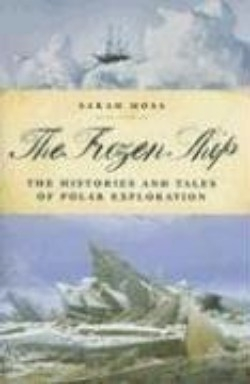The Frozen Ship
The Histories and Tales of Polar Exploration
One polar expedition goes terribly wrong: “in the last days the survivors tried to eat a lemming’s skull so old it crumbled in the hands of those who still had hands.” Such literature of misery, starvation, cannibalism, and death at the poles are the topics considered in this book.
The author presents polar exploration literature as a distinctive genre, documents the history of polar exploration writing, and critiques selections from the extant literature. This is not a book of adventure stories but a primer on polar exploration literature accompanied by traditional critical analyses. Although several complete stories of specific polar explorations are included, relating the full narrative is not the fundamental purpose of the text, which may leave average readers searching for full accounts from other sources. Moss is a lecturer in literature at the University of Kent and holds a doctorate from Oxford University; her background is apparent in her writing style, which is thesis-like and focused on language and semiotics.
The book is divided into a lengthy introduction and six parts that discuss specific topics, including long-term living in the arctic; voyages (most ending in catastrophe; starving, freezing, and dying or vanishing); recovering the long dead; women at the poles; and fiction involving the poles. Each part is further divided into two or three chapters. In general the book contains a large amount of quoted material from a wide variety of sources interspersed with commentary and criticism. The commentary sometimes extends beyond literary criticism and is often highly critical of the actions of certain polar explorers, and the world-view espoused by the author is occasionally at odds with the seeming reality of surviving in extreme environments.
Perhaps the most intriguing section of the book deals with the macabre but common practice of exhuming the frozen dead of past Arctic explorations for the purposes of autopsy and forensic reconstruction of disasters. For example, one grave opened in 1986 allowed researchers to discover that the unfortunate corpse had previously been exhumed in 1852—and yet the individual had been autopsied at death in 1846; thus John Hartnell, to date, has been autopsied three times over the course of a century and a half, and is firmly enshrined in the Arctic literature of “science and the Gothic.”
The book’s consideration of the literature of “these frozen axes, the almost unimaginable spaces which keep hours and seasons in their place and make the North cold and the South hot and the East early and the West late” is unusual and compelling and establishes a solid framework for further scrutiny of the stories and histories of polar exploration and frozen ships.
Reviewed by
Clark B. Timmins
Disclosure: This article is not an endorsement, but a review. The publisher of this book provided free copies of the book to have their book reviewed by a professional reviewer. No fee was paid by the publisher for this review. Foreword Reviews only recommends books that we love. Foreword Magazine, Inc. is disclosing this in accordance with the Federal Trade Commission’s 16 CFR, Part 255.

